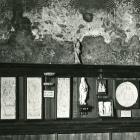The ground floor of the Sforza Castle, formerly the residence of the Lords of Milan, and the surrounding areas, houses the vast architectural and sculptural collections of the museum. The first permanent exhibition, “Greek, Etruscan and Roman Antiquities” was housed in Rooms I and II of the museum, while the extensive medieval collection was exhibited on the parterre of the courtyard and the Portico of the Elephant. Luca Beltrami, in collaboration with Carlo Ermes Visconti and Giulio Carotti decided that the smaller serial architectural elements, such as capitals and arch-stones should line the walls of chambers.
The choice of exhibits and their disposition within the museum was continually improved during the first half of the 20th century under the direction of the scientific directors Carlo Vicenzi and subsequently Giorgio Nicodemi. At the end of the Second World War, the museum underwent a transformation that radically altered the way the sculptures and monuments were displayed and experienced, ushering in a more innovative relationship between the institute and the visiting public.
Studio BBPR
Thanks mainly to an extraordinary intellectual synergy between the director of the collection, Costantino Baroni, and the Banfi, Belgiojoso and Peressutti architectural studio (BBPR), the Museum was given an indelible imprint, which to this day characterises an institute which is still seen to be one of the best examples of Italian museology. The presentation of the materials, which are visible in 3 dimensions, is made possible through a painstakingly careful and rational choice of exhibits. Almost sixty years since its inauguration on 12th March 1956, the critical acclaim of the Museum of Ancient Art has never waned and the quality of the works on exhibit continues to arouse interest, as illustrated by the ever growing number of visitors.









